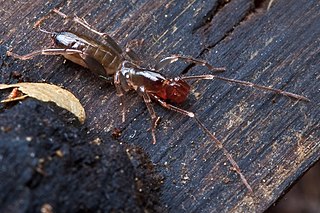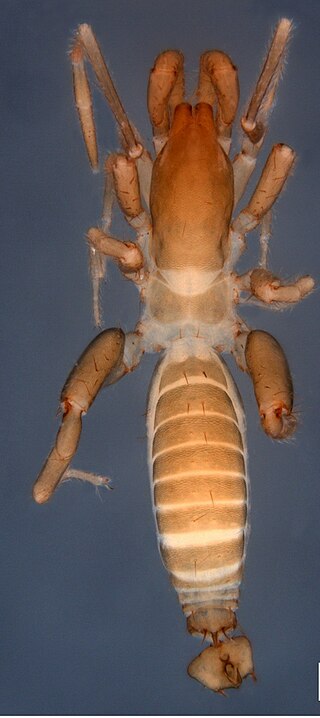
Schizomida, also known as sprickets or short-tailed whip-scorpions, is an order of arachnids, generally less than 5 millimetres (0.20 in) in length. The order is not yet widely studied. E. O. Wilson has identified schizomids as among the "groups of organisms that desperately need experts to work on them."

Hubbardiidae is a family of arachnids, superficially resembling spiders. It is the larger of the two extant families of the order, Schizomida, and is divided into two subfamilies. The family is based on the description published by Orator F. Cook in 1899. The American Arachnological Society assigns the common name hubbardiid shorttailed whipscorpion to members of this family.
Pacal is a genus of hubbardiid short-tailed whipscorpions, first described by Reddell & Cokendolpher in 1995.
Stenochrus is a genus of hubbardiid short-tailed whipscorpions, first described by Ralph Vary Chamberlin in 1922.

Rowlandius is a genus of hubbardiid short-tailed whipscorpions, first described by Reddell & Cokendolpher in 1995.
Mayazomus is a genus of hubbardiid short-tailed whipscorpions, first described by Reddell & Cokendolpher in 1995.
Schizomus is a genus of hubbardiid short-tailed whipscorpions, first described by Orator Cook in 1899.

Surazomus is a genus of hubbardiid short-tailed whipscorpions, first described by Reddell & Cokendolpher in 1995.
Hansenochrus is a genus of hubbardiid short-tailed whipscorpions, first described by Reddell & Cokendolpher in 1995.
Artacarus is a monotypic genus of hubbardiid short-tailed whipscorpions, first described by Orator F. Cook in 1899. Its single species, Artacarusliberiensis is distributed in Ivory Coast and Liberia.
Sotanostenochrus is a genus of hubbardiid short-tailed whipscorpions, first described by Reddell & Cokendolpher in 1991.
Cubazomus is a genus of hubbardiid short-tailed whipscorpions, first described by Reddell & Cokendolpher in 1995.
Vinabayesius is a genus of hubbardiid short-tailed whipscorpions, first described by Teruel & Rodriguez-Cabrera in 2021.
Heteroschizomus is a genus of hubbardiid short-tailed whipscorpions, first described by Jon Mark Rowland in 1973.
Baalrog is a genus of hubbardiid short-tailed whipscorpions, first described by Monjaraz-Ruedas, Prendini & Francke in 2019.
Nahual is a genus of hubbardiid short-tailed whipscorpions, first described by Monjaraz-Ruedas, Prendini & Francke in 2019.
Harveyus is a genus of hubbardiid short-tailed whipscorpions, first described by Monjaraz-Ruedas, Prendini & Francke in 2019.
Schizophyxia is a genus of hubbardiid short-tailed whipscorpions, first described by Monjaraz-Ruedas, Prendini & Francke in 2019.
Agastoschizomus is a genus of protoschizomid short-tailed whipscorpions, first described by Jon Mark Rowland in 1971.
Protoschizomus is a genus of protoschizomid short-tailed whipscorpions, first described by Jon Mark Rowland in 1975.





